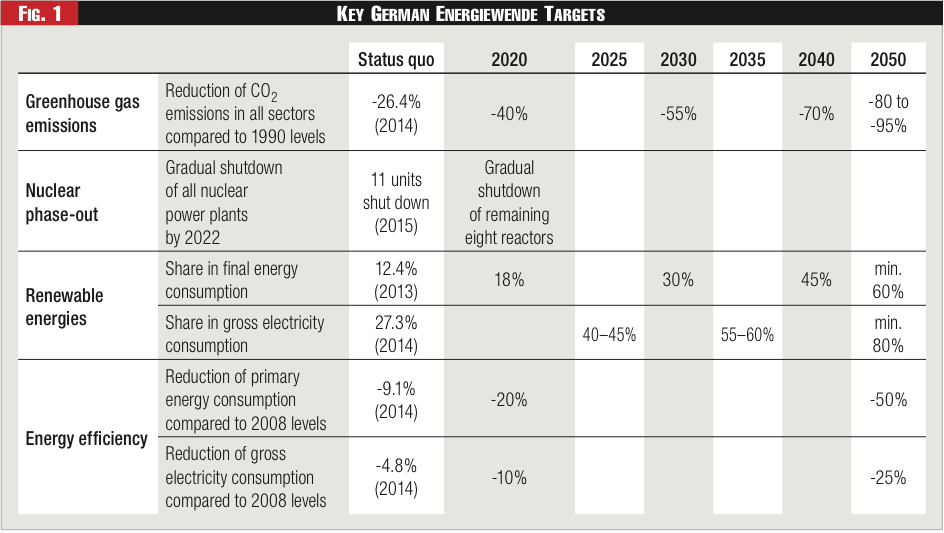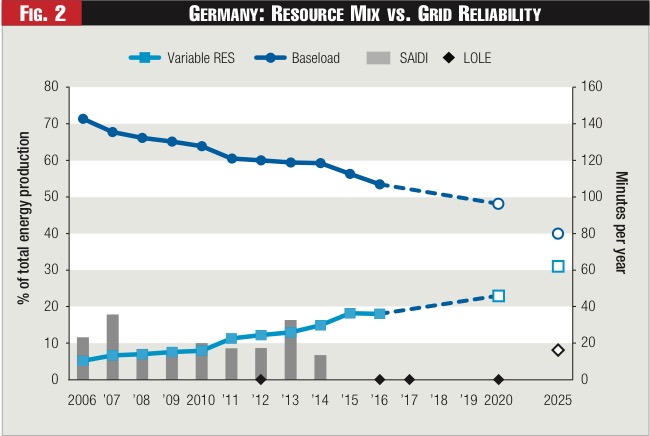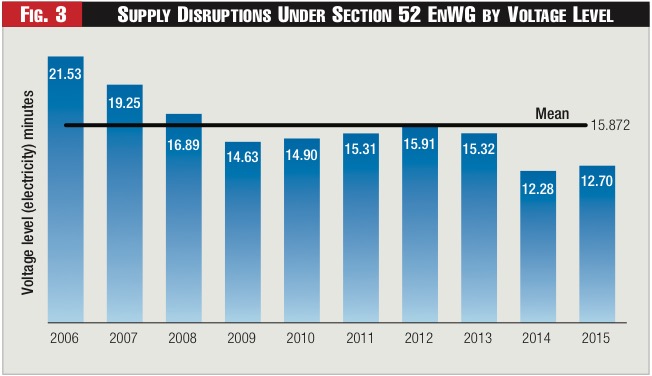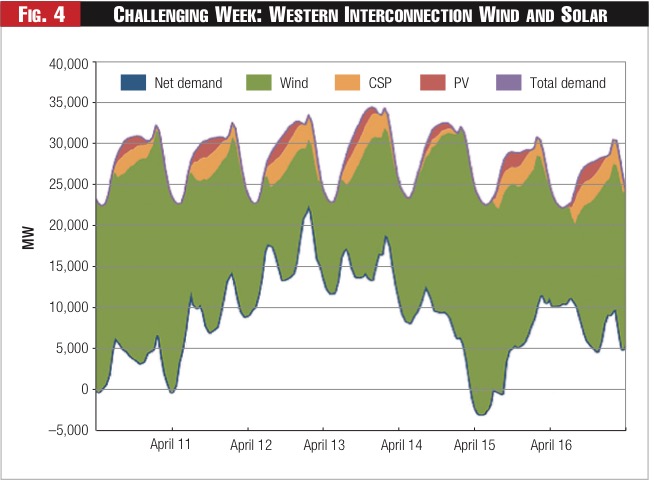
The experience of the German Energiewende shows that increasing amounts of renewable energy on the power system, while at the same time reducing inflexible baseload generation, does not harm reliability write Michael Hogan, Camille Kadoch, Carl Linvill and Megan O’Reilly of the Regulatory Assistance Project (RAP). American policymakers who are still skeptical can look across the Atlantic, to Germany, for a concrete example of a successful transition away from traditional baseload, the authors note. Courtesy Public Utilities Fortnightly.
The power system in the United States, like that in numerous other countries throughout the world, is in a period of transition.
Overall, generation is shifting away from large, inflexible thermal generation, that is, traditional baseload generation, and toward smaller, more dispersed, variable renewable resources. This transition is occurring both because citizens are calling for less carbon-intensive resources, and simply because wind and solar have become among the least expensive resources.
U.S. natural gas prices have declined and the cost of renewables has come down dramatically.
A recent report from the R Street Institute, “Embracing Baseload Power Retirements,” noted that “Historically, conventional baseload resources were integral to achieving portfolio reliability at least cost, but some of these resources no longer provide the most economical means to meet reliability needs.”
Most studies have found that reliability and least cost are best served by reducing the share of inflexible baseload generation
This shift has triggered a debate among some U.S. policymakers about reliability and the continued need for baseload power plants such as coal and nuclear. Scott Pruitt, head of the Environmental Protection Agency, has said that coal-fired power plants are key to preserving electricity reliability. This thinking is likewise reflected in the U.S. Department of Energy’s recent proposal to allow special cost recovery for generators that can store ninety days of fuel on site.
Reliability with renewables
However, numerous studies sponsored by utilities, system operators, the national labs, and others show that a large share of variable renewable energy production can be integrated while keeping the lights on, without any valuable role for traditional baseload.
No study, not even by the Department of Energy, which examined this issue in an August 2017 Staff Report on Electricity Markets and Reliability, has found evidence that baseload generation is required for reliability. Most studies have found that reliability and least cost are best served by reducing the share of inflexible baseload generation.
To the extent that reliability is a concern, it is not one driven by a lack of available generating capacity. A recent report from Rhodium Group found that a mere 0.00865 percent of all customer service hours lost from 2012 to 2016 were due to either fuel supply emergencies or other concerns about the availability of generation.
In spite of the fact that Germany is meeting nearly a fifth of its electricity requirements with VREs while retiring inflexible thermal generation, the nation has not experienced reliability problems on either the distribution or bulk electric system
American policymakers who are still skeptical can look across the Atlantic for a concrete example of a successful transition away from traditional baseload. Germany traditionally relied on a significant share of inflexible thermal generation such as coal and nuclear to supply the grid. Resources were dispatched to meet load, and variable resources were few.
Now, Germany is a leader in the early adoption of variable renewable energy resources (VREs). The country has shown leadership by pursuing what it calls the Energiewende or energy transition, which has set a national goal of eighty percent decarbonization
by 2050.
Government statistics show that VREs now make up eighteen percent of the German electricity mix, and all renewables, including hydro, account for twenty-nine percent. At the same time, Germany is phasing out baseload nuclear plants and is also working on decarbonizing its remaining energy mix by phasing out inflexible baseload coal- fired generation.
In spite of the fact that Germany is meeting nearly a fifth of its electricity requirements with VREs while retiring inflexible thermal generation, the nation has not experienced reliability problems on either the distribution or bulk electric system. If anything, government data show that the reliability of the German system has increased.
About the Energiewende
The German Energiewende is one facet of the government’s commitment to an aggressive, economy-wide reduction in greenhouse gas emissions. The Energiewende has set ambitious targets for renewable energy.
Renewables should make up at least fifty percent of the power generation mix by 2030, sixty percent by 2040, and eighty percent by 2050. Germany has significantly diversified its electricity mix toward renewables, which grew from just four percent in 1990 to the current twenty-nine percent.
As a spokeswoman for the Federal Ministry of Economics and Energy has put it, “baseload is no longer needed,” otherwise it could “block the grid”
Germany’s goal of eighty percent renewable energy by 2050 now has to be met at the same time as the country retires its nuclear fleet. After the nuclear accident at Japan’s Fukushima Daiichi plant in March 2011, the German government set a nuclear phase-out deadline of 2022. As part of this move, the seven oldest nuclear reactors were immediately shut down.
To meet these goals, the country is anticipating a future with large amounts of variable renewables, no nuclear power, and very small amounts of fossil fuels. In this context, dispatching large thermal power plants in baseload service to meet demand is increasingly outmoded.
Germany already produces hours of nearly a hundred percent renewable electricity on the system. As a spokeswoman for the Federal Ministry of Economics and Energy has put it, “baseload is no longer needed,” otherwise it could “block the grid.” This has consequences for the inflexible thermal generation that remains on the system.
See Figure One.

During hours of low VRE production, baseload plants that were displacing cheaper energy sources leading up to these hours have little or no capacity in reserve, requiring investment in additional, peaking generation capacity that sits idle most of the time.
By contrast, more flexible, dispatchable generation that can ramp down during periods of high VRE production can maximize the use of cheap energy, while at the same time inherently providing the reserve capacity needed for other hours.
Germany eventually envisions moving to an electricity market 2.0 where the focus shifts to balancing net load. Inflexible baseload generation will be used infrequently because it is not competitive with more flexible supply-side and demand-side resources in many hours. Wind and solar would provide the bulk of energy over a regional grid, with smart demand-side flexibility and more flexible load-following thermal generation helping to balance out the system.
What has this meant in practice?
With the share of renewable production now close to a third of the total electricity mix, and with nuclear plants retiring, how is the reliability of the German electricity system faring?
The chart below tracks the trends in the country’s energy mix as well as System Average Interruption Duration Index (SAIDI), a measure of the annual average duration of interruption in customer service from all causes, indicated in minutes per year.
The chart also shows Loss of Load Expectation (LOLE) numbers, a widely-used measure of resource adequacy that assesses how many minutes a year, on average, the available generation capacity in a given control area is likely to fall short of total demand.
Both the SAIDI and LOLE numbers show that increasing amounts of VREs and decreasing baseload production have not negatively affected reliability in Germany to date.
See Figure Two.

Both the SAIDI and LOLE data indicate that reliability has followed historic trends. e potential uptick in LOLE numbers for 2025 reflects the fact that LOLE nearly always shows an increase that far into the future, because LOLE only reflects committed generation investments and commitments to new resources that are normally made within a five-year time frame.
Even the projected uptick should be put into perspective: it projects an LOLE of less than twenty minutes per year, well below the prevailing U.S. standard of a hundred and forty four minutes per year.
A more granular analysis of SAIDI numbers over the past decade indicates that the reliability of the medium- and low-voltage system has in fact improved over this period. The next chart tracks the duration of disruptions attributable to distribution system events between 2006 and 2015 – showing a clear decline over that period.
The Bundesnetzagentur Monitoring Report 2016, from which this data is drawn, noted that “the energy transition and the associated increase in embedded generation does not appear to have had a discernible impact on the quality of supply in 2015.”
See figure three.

System adequacy in Germany is based on a national power balance, but given that electricity is traded cross-border in the European interconnected system, the SAIDI and LOLE numbers in this context are being considered in a vacuum. Weighing the availability of resources across the wider European system would presumably increase reliability even further.
What does the Energiewende teach us about what resources are needed?
The Energiewende also demonstrates the types of resources that are needed on a system with large amounts of VREs. The figure below illustrates this.
Prior to integration of VREs, system operators needed to meet fairly predictable total demand (top line in purple) with dispatchable generation sources, with a substantial amount of non- fluctuating demand.
However, in a system where variable resources are integrated fully, dispatchable resources now need to follow changes in the residual “net demand” (blue line) not already served by “free” energy from variable renewables, and very little of the net demand is non- fluctuating.
See Figure Four.

Baseload resources, traditionally nuclear and coal plants, are not technically or economically well suited to this new paradigm. It will be more volatile and costly to balance the system if the dispatchable resource base continues to be dominated by inflexible baseload generation. To the extent there is a demand for generation to be operated round the clock, more flexible plants are fully capable of meeting this need.
This is good news for consumers. Currently, grid operators dispatch wind and solar first because they have the lowest operating costs. The weather-dependent nature of the resources creates a need for other resources to adjust their dispatch more frequently and extensively to balance system supply and demand.
By removing inflexible baseload in favor of more flexible load-following plants, consumers realize the full benefit of the lowest-cost resources while receiving the same quality of service
Continuing to rely on inflexible baseload would require curtailment of less costly energy. The alternative is an economic mix of VREs and load-following plants that displaces baseload operations. By removing inflexible baseload in favor of more flexible load-following plants, consumers realize the full benefit of the lowest-cost resources while receiving the same quality of service.
Germany is now debating how increasing shares of VRE can be integrated cost-effectively. In the spring of 2017, the country’s national regulatory authority published a report that analyzed five events in 2015 where a high share of VREs on the grid coincided with negative market prices.
The report closes by recommending further ways to decrease costs of VRE integration while decreasing inflexible thermal generation. Recommendations included better forecasting (of load, and of renewable energy supply), support for infrastructure investments, better use of spinning reserves, and other system improvements.
Resource capabilities, not baseload resources
The experience of the Energiewende shows that increasing amounts of renewable energy on the power system, while at the same time reducing inflexible baseload generation, does not harm reliability and can lower the cost of VRE integration. Indeed, the German data suggest that reliability has actually improved under these conditions.
For regulators and policymakers in the U.S. deliberating whether and how to respond to federal officials and others who insist that inflexible baseload is essential for reliability, the German experience offers important evidence to the contrary
What the Energiewende does demonstrate is a need for greater system flexibility. Germany’s energy transformation envisions a grid where conventional thermal generation would follow “net load,” meeting short- term energy demand in some hours and the demand for flexible reserves in other hours, and variable renewable energy such as wind and solar energy would provide the bulk of energy over a regional grid. The Energiewende provides evidence that this type of system can be reliable and is attainable.
For regulators and policymakers in the U.S. deliberating whether and how to respond to federal officials and others who insist that inflexible baseload is essential for reliability, the German experience offers important evidence to the contrary.
Editor’s Note:
The Regulatory Assistance Project (RAP) is a globally operating independent and nonpartisan team of experts. Michael Hogan is a senior advisor to the Regulatory Assistance Project (RAP), working on issues related to power market design, integration of low-carbon supply, system planning, and demand response in the United States and Europe. Camille Kadoch is RAP’s general counsel and publications manager. Dr. Carl Linvill is a RAP principal, leading the organization’s efforts on renewable energy integration and trans- mission planning in the Western United States. Megan O’Reilly is an environmental lawyer and principal and owner of Arc Research and Analysis; she worked with RAP and Agora Energiewende as a Robert Bosch Fellow in 2016-2017.
This article was originally published in the February 2018 issue of Public Utilities Fortnightly (www.fortnightly.com). Permission to republish this article in EnergyPost has been granted by the publisher.
























Sign in to Participate